uniform size box 10 x10x 4 1/2 and weight 11 pounds
Better known as the Red Cross Box, the American
Red Cross Prisoner Of War Food Package NO 10, was sent to American POWs in
whatever country they were in during WW2.
Those prisoners in Europe such as Sgt Thomas Mirando of Delmar fared
better in receiving the package then Sgt George Kerekesh and Pvt Millard C
Smith, both of Delmar, who were in Japan occupied territory. In many cases the Germen let the POWs have
the entire box, in other cases they would only let them have the candy and cigarettes
and keep the rest for the prison cookhall where they were combined with the
German POW food. The Japanese rarely let
the POWS have anything.
100,000 boxes a month were filled in
Philadelphia and shipped to Geneva
Switzerland where they were distributed across Europe. Some packages were shipped and stored at
Vladivostock and stored on site until Japanese vessels picked them up for
possible distribution to prison camps in Asia.
Letter from William H Jopp of Denton, Maryland
POW in Germany
Dear Mother,
Well, it is your turn to get a letter
although there isn't much to write about.
I hope you and Daddy are ok. The only thing I can think to write about
now is the Red Cross parcel we get every week and today is the day. We get 1 can of corned beef, can of minced
pork (lunch meat) 1 box of cheese, 4 to 6 packs of smokes, 1 can butter, 1 can
of liver paste, 1 can powder milk, 2 candy bars, 1 can of orange juice, 1 can salmon,
1 box of crackers, 1 box sugar cubes, 1 box of prunes, or raisins, 2 small bars
soap, and 1 can coffee. It sure is a nice box. With this box and the German
rations I can make out all right. We have plenty books to read. I will write
again next week,
Billy




















































